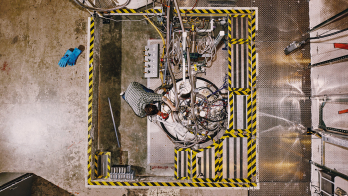Scintillation counters, with their simplicity and fast response, have been the quintessential tool for triggering in particle physics since they were first coupled with photomultiplier tubes (PMTs) some 60 years ago. However, the bulky, fragile, high-voltage-driven PMT looks set to be replaced by a much simpler and smaller silicon device. Thanks to the rapid development of semiconductor technologies during the past decade, the detection of light produced by ionizing particles in scintillating plastic can now be performed efficiently by inexpensive miniature photodiodes.

Taking advantage of this technique, physicists from the Institute for Theoretical and Experimental Physics (ITEP) in Moscow, who are part of the ALICE collaboration at CERN, have developed a scintillation counter in which the light is read out by high-gain avalanche photodiodes, embedded directly inside the scintillating plastic. The metal/resistive-layer/silicon (MRS) avalanche photodiodes (APDs) have a sensitive surface of 1 mm2, and when operated in the so-called “Geiger” mode provide a million-fold amplification of initial photo-ionization. This makes them sensitive even to single photons in the green region of the visible light spectrum. In contrast with standard PMTs, MRS APDs are biased at a low voltage of 30-50 V, consume little power and are not influenced by magnetic fields. Moreover, their current price is significantly lower than that of PMTs.
The team has developed a detector they call START, for Scintillation Tile with MRS APD Light Readout, which consists of a scintillating plastic plate, a piece of wavelength-shifting optical fibre installed in a circular groove inside the plate, two MRS APDs working in coincidence, an opaque wrapper and a front-end card mounted directly on the detector. Various versions of START have been thoroughly tested using cosmic rays and have shown operational consistency, excellent detection efficiency and good homogeneity.
An area of almost 4 m2 comprising 170 START tiles, each 15 × 15 ×1 cm3, has been assembled as part of the Time-of-Flight (TOF) project for the ALICE detector, which is under construction for the Large Hadron Collider. They will be used as cosmic-ray triggers in a larger system of STARTs for regularly testing the ALICE TOF system components.
Further reading
A Akindinov et al. 2005 Nucl. Instr. and Meth. A 539 172.








